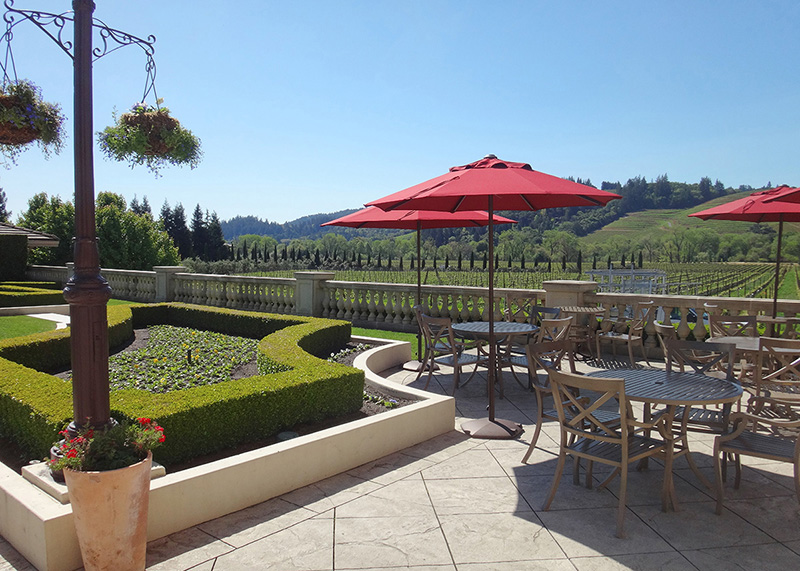
The vineyards seen from the terrace of Ferrari-Carano Winery are part of a Sonoma Valley wine-making tradition that dates back to the 1850s.

The vineyards seen from the terrace of Ferrari-Carano Winery are part of a Sonoma Valley wine-making tradition that dates back to the 1850s.
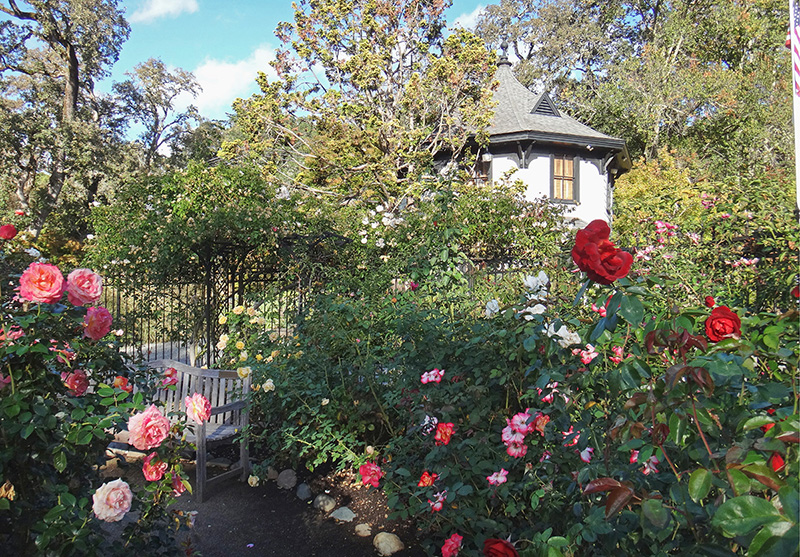
The new Rose Garden and the old Octagon House at the Marin Art and Garden Center.
30 Sir Francis Drake Boulevard, Ross, CA 94957
Visit year-round; March–June for roses
|
(415) 455-5260 |
|
Open Mon–Sat 9am–5pm; closed holidays |
|
Admission free |
|
Dogs on leash |
Community-minded park with heritage trees and eclectic gardens
There are plenty of scenic spots to enjoy in Marin County. Head north across the Golden Gate Bridge (but not at rush hour) on Highway 101 and you’re on your way to the Muir Woods redwood forest, the Marin Headlands, Stinson Beach, Point Reyes National Seashore, and Mt. Tamalpais.
The town of Ross, home to the Marin Art and Garden Center (MAGC), is located about eighteen miles north of San Francisco. This intriguing oasis, with its heritage trees, cache of vintage buildings, and assorted gardens is a microcosm of Marin County history.
If you live in the vicinity you’re probably aware of MAGC’s many community programs—it’s been hosting artistic, cultural, and horticultural events since it was founded in 1945. Before that, the property was part of a private estate called Sunnyside. Before that, it was part of a vast Mexican land grant and called Rancho Punta de Quentin. And before any of that, it was known to the Coast Miwok indigenous peoples, hunter-gatherers who occupied today’s Marin County for thousands of years before the Spanish arrived in the late 1700s. This overlay of history, reflected in the parklike grounds and gardens, adds to the pleasure of a visit.
To my mind, a chronological tour of these grounds is more interesting than an entrance-to-exit walk-through—at least in writing. Let’s start with the Native Basketry Garden in Redbud Gulch, behind the theater barn. Developed by renowned basketry and plant artist Charles Kennard, this habitat garden is a living history book that shows the kinds of plant materials used by native peoples, including the Coast Miwoks, for making baskets. It was developed around a patch of native Santa Barbara sedge (Carex barbarae) and includes flexible-stemmed willows (Salix), elderberries (Sambucus), western redbud (Cercis occidentalis), western leatherwood (Dirca occidentalis), grasses, and other plants used for weaving by indigenous tribes for millennia.
Trees can provide a unique link to the past. Take a look at the pear tree growing in front of the Octagon House. It’s a graft taken from the last remaining pear tree in the orchard of Mission San Rafael, established in 1817. The Spanish Franciscans founded missions up and down the coast, established the first gardens in California, and introduced the first European fruits, grains, and vegetables. The old pear is one of several fruit trees scattered around the grounds (including orange and apple) adding fragrance in the spring and rich color in the fall (persimmon). Look for them near the Livermore Pavilion and around the edges of the property.
In 1821, following the Mexican War of Independence, the Spanish missions were disbanded and the enormous land grants bestowed by the Spanish crown came into Mexican hands. The land occupied by the MAGC was part of the 8,877-acre Rancho Punta de Quentin. But when the United States took control and California became a state in 1850, the Mexican land grants were up for grabs. James Ross, a liquor merchant from San Francisco, bought a portion of the ranch and settled there in 1857. (The town of Ross is named for him.) His tenure is marked by the presence of the majestic English oak (Quercus robur) near the entrance. The tree, one of the largest of its species in the country, was planted in 1860. The garden’s oak collection also includes several evergreen coast live oaks (Q. agrifolia), white oaks (Q. alba), and red oaks (Q. rubra).
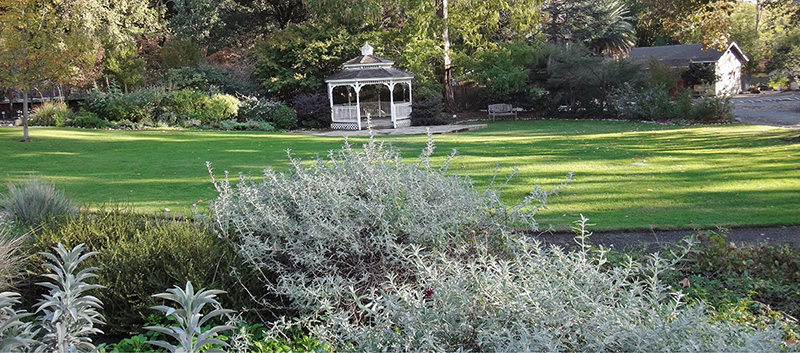
The history of the Marin Art and Garden Center stretches back to a time before California’s statehood.
After Ross’s death, George Worn, his business associate, married Ross’s daughter Annie. The couple took possession of twenty-two acres of the property—the site that is now the Marin Art and Garden Center—and built a grand house they called Sunnyside. The Worns’ tenancy resulted in a small building called the Octagon House, built in 1864, where they lived while Sunnyside was being built. (The building now serves as the Moya Library.) A giant sequoia planted in 1875 also remains from the Worn era. (George and Annie’s daughter, Isabella, became a noted horticulturist in the Bay Area and served as the chief gardener at Filoli.)
The Worns’ fortunes took a nosedive in 1886, when the silver markets tanked. Sunnyside was sold to Jonathan Kittle and his wife Harriett, twenty years his junior. They doubled the size of the house and lived there with their four children until the house burned down in 1931. Today, a fountain marks the site where the house stood.
After the fire, the property sat unused and derelict until two remarkable women, Caroline Livermore and Gladys Smith, managed to raise funds to acquire and preserve it as a community resource. Livermore and Smith were community activists and conservationists at a time when Marin County was growing rapidly. The Marin Art and Garden Center opened in 1945 and served as the headquarters for several horticultural, cultural, and artistic groups.
With the exception of the Octagon House and the magnificent heritage trees, everything you see here dates from about 1947 onward. There has been an increasing emphasis on ecology, organic gardening techniques, and the use of native and drought-tolerant plants in the ornamental and demonstration garden areas that have been created over the past seventy years. In the Habitat Garden and the Sun Garden you’ll find a colorful mix of salvias, milkweed, verbena, goldenrod, coreopsis, matilija poppies, several varieties of California lilac (Ceanothus), and more.
The lovely Rose Garden, enclosed within a decorative wrought-iron (deer-proof) fence, was planted in 2004 by the Marin Rose Society. The oldest garden is the Memory Garden, completed in 1953 as a quiet spot for remembrance and reflection. Two statues, The Reclining Lady and The Standing Lady, grace this peaceful area behind the Octagon House. The Memory Garden seems an apt place to end this tour through time of a place so rich in Marin County history.
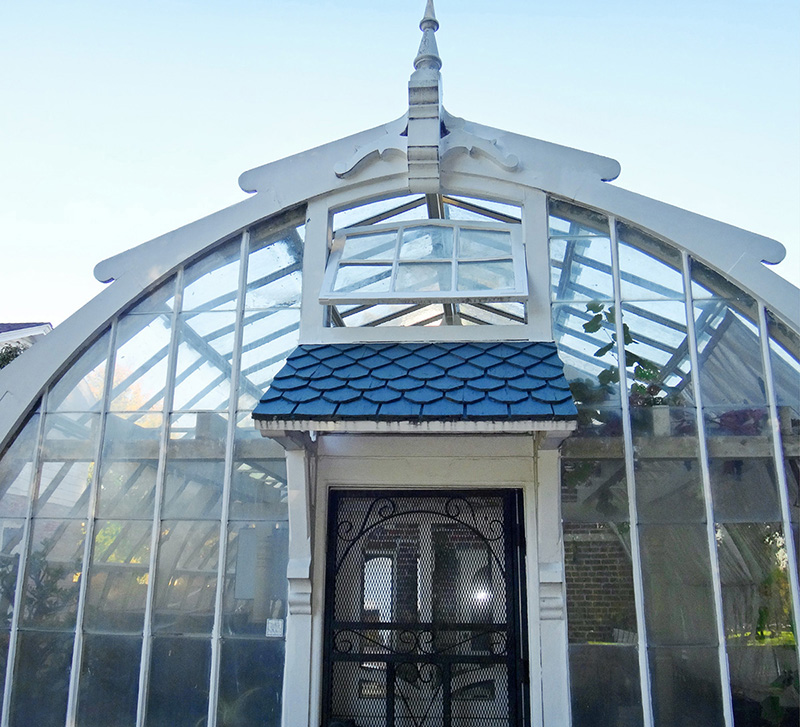
Luther Burbank designed this greenhouse as his office and plant laboratory in the 1880s.
204 Santa Rosa Avenue, Santa Rosa, CA 95402
Visit year-round; May and June for roses and poppies
|
(707) 524-5445 |
|
Gardens open daily 8am–dusk; museum open Apr–Oct Tues–Sun 10am–4pm |
|
Admission free |
|
No dogs |
A step back in time to the home and gardens of America’s greatest plant breeder
You can thank Luther Burbank (or not) for those McDonald’s french fries you keep vowing to stop eating. Most of McDonald’s fries are made from a potato known as Russet Burbank, a brown-skinned spud that’s an offshoot of the Burbank, a potato Luther Burbank developed in 1872. You couldn’t patent potatoes back in those pre-Monsanto days, so Burbank sold the rights to his new potato for $150 and used the money to move to California.
It was the smartest business move this pioneering plant breeder ever made. For the rest of his life, Burbank lived in Santa Rosa and carried out his endless and exacting plant experiments in the gardens surrounding his home and at Gold Ridge Farm in nearby Sebastopol.
The Burbank potato made Luther Burbank (1849–1926) famous. But you can also thank him every time you bite into the sweet strawberry-orange flesh of a Santa Rosa plum, a variety he introduced in 1906. Soon after, he crossed plums and apricots to create the first plumcots. The Royal walnut trees he developed in the 1880s became the standard commercial walnut trees in the country. And how about that white blackberry he created? Burbank was as interested in ornamental flowers as he was in edible fruits, vegetables, nuts, and grains. Those lovely Shasta daisies you grow in a sunny spot in your garden—the ones with the white petals and golden centers—were introduced by Luther Burbank in 1901 after seventeen years of labor.
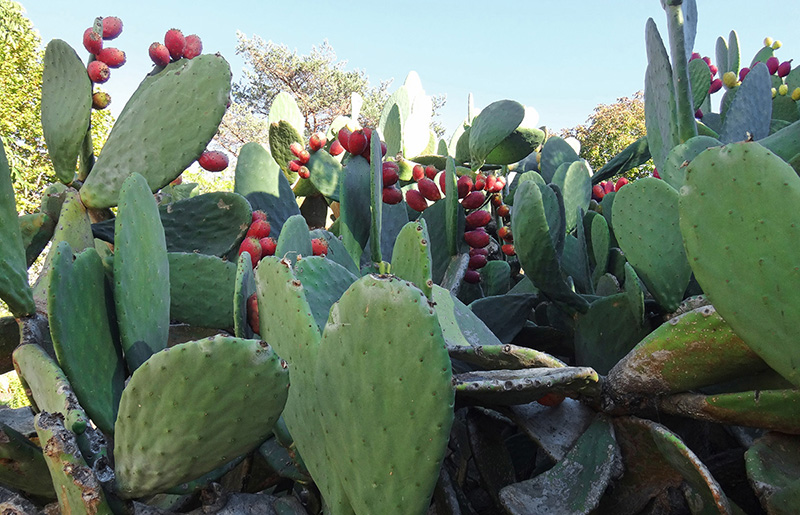
Between 1907 and 1925, Luther Burbank developed over sixty varieties of spineless cacti for possible use as cattle fodder.
The list of Luther Burbank’s more than 800 plant creations, inventions, innovations, hybrids, novelties, improvements, and introductions is staggering. This transplanted New Englander, a self-taught man who never finished high school, became the most famous horticulturist in the world. He was a household name in pre-supermarket days, when people who grew their own food and flowers were constantly on the lookout—as were farmers, nurserymen, and orchardists—for better-tasting, faster-growing, longer-lasting, and nicer-looking fruits, flowers, and vegetables. Burbank was the rock star of the plant world to them, a cross between a wizard and a saint, a man so revered that his birthday (March 7) is celebrated as Arbor Day in California and trees (probably his own hybrids) are planted in his honor.
Burbank was a plant inventor more than he was an environmentalist. He developed the famous spineless prickly pear cactus (I guess we could call it the prickless pear) as cattle fodder, with the goal of turning the desert into one vast ranch for grazing cattle. That the cattle would destroy entire desert ecosystems apparently didn’t concern him. Because here’s the thing: every native plant Burbank saw—from the persimmon to the poppy to the cactus—he wanted to “improve” and make “better” or more “useful.” He also introduced the Himalayan blackberry that now runs rampant and is the bane of farmers and gardeners everywhere.
That’s not to denigrate his achievements, which you’ll learn about in fascinating detail on a visit to the Luther Burbank Home and Gardens in Santa Rosa. Some of his more notable creations can be seen in the 1.5-acre garden-park that surrounds the modified Greek Revival house where Burbank lived with his mother and sister from 1884 to 1906. The property, which includes the rather charming greenhouse he designed in 1889 and used as one of his plant laboratories, is a registered National, State, and City Historic Landmark. In 2005, the carriage house was transformed into an attractive museum devoted to Burbank’s accomplishments. The grounds include a Wildlife Habitat Garden, an Edible Landscape Garden, and a Medicinal Garden.
But what about Burbank’s personal life? The facts we have seem to indicate that it was easier for Burbank to be intimate with plants than with people. He was born in Lancaster, Massachusetts, the thirteenth of eighteen children. His mother and sister moved out to California to be with him and provided much of his emotional sustenance. His first wife was one Helen Coleman from Ohio. Though no one in that tight-lipped age used the term “battered husband,” that appears to be what Burbank was. (At one point Helen gave him a black eye.) After divorcing her in 1896 and paying out a big settlement, Burbank remained single until 1916, when he married his secretary, Elizabeth. She was twenty-nine. Elizabeth adored him. Burbank died in 1926, Elizabeth in 1977. She’s the one who had the memorial fountain built and who donated the property to the city of Santa Rosa.
If you can, book a docent-led tour that takes you inside the Luther Burbank House. After Burbank’s death, Elizabeth moved into this house, where Burbank had once lived with his mother and sister. It’s a cozy, charming period piece that instantly transports you back to the age of antimacassars, writing desks, and upright parlor pianos. And it’s loaded with Burbank memorabilia—like that famous photograph of Luther Burbank standing with Henry Ford and Thomas Edison: the Big Three inventors of what was fast becoming the modern age. Consider combining your visit here with a trip to nearby Gold Ridge Farm in Sebastopol, where Burbank carried out most of his plant-breeding experiments.
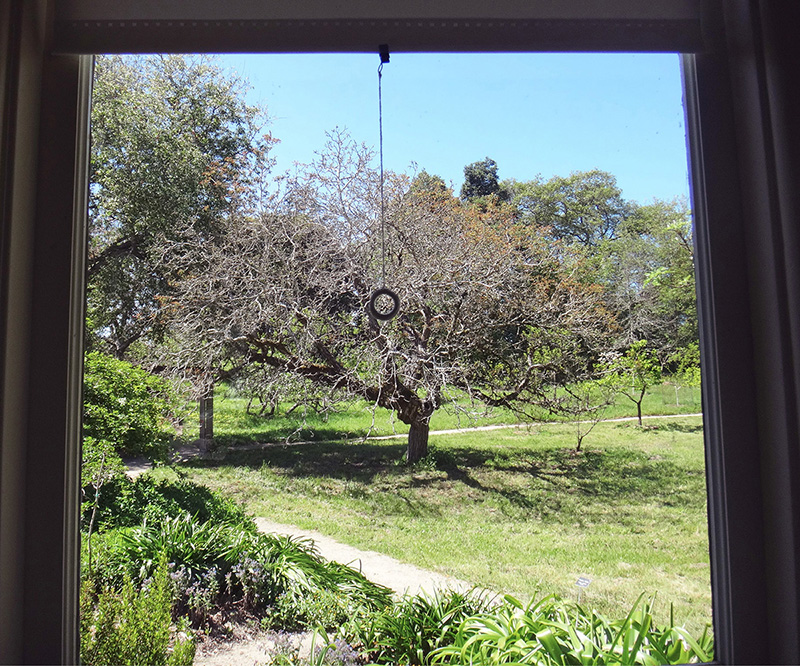
From this window in his foreman’s cottage, Luther Burbank could look out at the fields of his experiment farm in Sebastopol.
If you’re interested in the working methods and botanical offspring of this fascinating plantsman, drive about seven miles west from Santa Rosa to visit Gold Ridge Farm (entrance at 7777 Bodega Avenue, Sebastopol, CA 95472; grounds open daily). This three-acre remnant of Burbank’s ten-acre experiment farm still contains trees, flowers, and vines planted by or descended from the ones Burbank planted more than a hundred years ago. For his experiments, he would plant thousands of saplings, sprouts, or seedlings close together in long north-south rows so he could more easily inspect each plant and choose the best for continued work. He bought the land in 1885 and bicycled over every day to propagate, cross-pollinate, hybridize, graft, bud, sprout, and select his plants. Sometimes he would stay overnight in the now-restored foreman’s cottage. You can visit the cottage on a docent-led tour, but it’s really the gardens you want to see. They’re a little ghostly, but they provide a living link to the remarkable achievements of Luther Burbank.
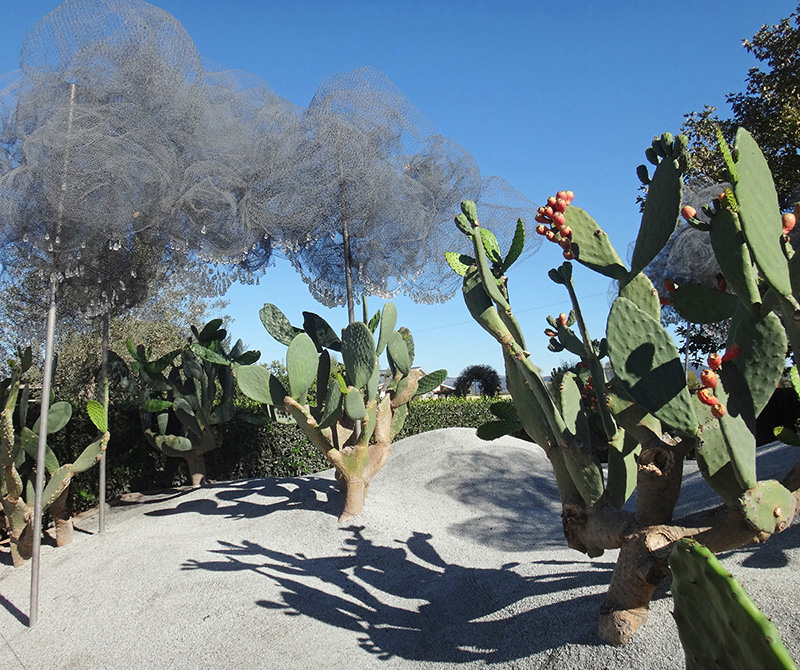
Shimmering clouds of chicken wire and crystals float above cacti and crushed oyster shells in White Cloud, an art garden at Cornerstone Sonoma.
23570 Highway 121, Sonoma, CA 95476
Visit year-round; art gardens are prettiest in the spring
|
(707) 933-3010 |
|
Open daily 10am–4pm |
|
Admission free |
|
No dogs |
A gallery of contemporary gardens and the Sunset test gardens highlight this upscale retail setting
Gardens, wine, and shopping—it may sound like the title of a Strauss waltz, but it’s what Cornerstone Sonoma is all about. This unique combination of outdoor market and art gardens in the heart of California’s Wine Country lets you explore some interesting gardens, sip a glass of wine, and squeeze in some upscale shopping—all in one pleasant location. There’s food, too, of course, and sometimes there’s live music. Better give yourself a couple of hours to enjoy it all. And bring a sun hat.
Cornerstone Sonoma is located on the east side of Highway 121, about forty-four miles north of San Francisco. It has a lot to catch your eye and pique your senses. But it’s the assemblage of small gardens designed by an international roster of landscape architects and designers that gives Cornerstone its garden edge.
The idea for an outdoor gallery of contemporary gardens started well over a decade ago when Chris Hougie and Teresa Raffo visited the International Garden Festival at Chaumont-sur-Loire in France. At this yearly event, about thirty landscape artists create gardens on a specific theme that typically involves the interaction of art, architecture, and nature. When the California couple inaugurated Cornerstone (then called Cornerstone Festival of Gardens), the invited artists didn’t have to adhere to a theme. They were each given 1,800 square feet of land on which to create their gardens, art installations, or landscape statements. Until 2016, there were twenty side-by-side gardens in this one-of-a-kind garden gallery. Today there are nine.
The change occurred when the property was sold, the new owner re-envisioned the space, and Sunset magazine came into the picture. A premier West Coast lifestyle magazine, Sunset needed a place for new test gardens and an outdoor demonstration kitchen. It was a perfect fit for Cornerstone, but it meant that over half of the art gardens had to be removed to make room. Luckily, the nine remaining gardens were the most edgy, interesting, and playful of the original group. And the presence of Sunset brings a contemporary, homegrown relevance to Cornerstone by promoting and demonstrating how to grow and enjoy your own fruits, flowers, and vegetables.
The five new Sunset test gardens and outdoor kitchen take up about a quarter of an acre along the south edge of the property. Designed by Homestead Design Collective, the gardens are themed rooms devoted to interesting ornamental plants that can also be harvested and used in entertaining. The Cocktail Garden features lemon and other citrus trees, pomegranates, pineapple, guava, and hops, all used to augment, infuse, or flavor drinks. The Backyard Orchard focuses on stone fruit trees underplanted with ornamental grasses and perennials. In the Farm Garden, veggies are grown in raised beds and cherry tomatoes are trained on stainless steel trellises. The Flower Room showcases unusual flowers and shrubs, while the Gathering Space highlights the retail plant line offered by Sunset. The outdoor kitchen is used for creating, testing, demonstrating, and photographing new recipes and kitchen crafts.
The art garden installations are located just beyond the Sunset gardens and range along the eastern perimeter of the complex. The first one you’ll see is John Greenlee’s Mediterranean Meadow. Greenlee is a leading expert on ornamental grasses and sedges, and that’s what he’s planted on this prairielike hillock. Walk through on the winding path. It’s a lovely, simple garden, full of movement and subtle colors that shift with the changing light of day. Taiwan-born landscape designer Conway Cheng Chang’s In the Air is an installation that uses plants to ask questions about plant and human interdependence and adaptability to air. Next to it is Garden of Contrast, a beautiful work by James A. van Sweden and Sheila Brady. Here, a circular space divided into small fields by a rosemary hedge is planted with low grasses, agaves, and bright poppies. Beyond it is Eucalyptus Soliloquy by Walter Hood and Alma Du Solier, a corridor of walls created from Sonoma’s nonnative eucalyptus trees, which form a windbreak between the fields and the surrounding vineyard. The naturally decaying eucalyptus wood, leaves, and seeds are an integral part of the installation.
California is an agricultural giant that depends upon thousands of migrant workers to harvest its crops. Small Tribute to Immigrant Workers, created by Mario Schjetnan of Mexico City, is a strong, simple memorial with portraits of farmworkers and a small shrine set into a stone wall above a reflecting pool. Roger Raiche and David McCrory of Planet Horticulture in San Francisco created Rise, the installation beside it. The piece consists of a hill planted with trees and shrubs, with a large corrugated metal pipe passing through it. When you walk through the pipe you enter a different garden space on the other side.
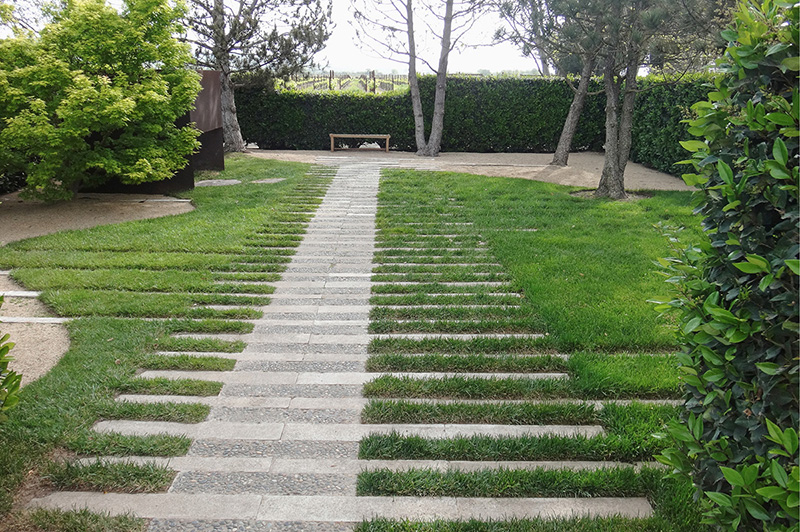
The Garden of Visceral Serenity, Yoji Sasaki’s peaceful contribution at Cornerstone Sonoma, is surrounded by shrubbery.
The Garden of Visceral Serenity by Yoji Sasaki of Osaka, Japan, is a quietly reflective enclosed garden. A granite stone path runs through it, with diagonal side ribs forming a calm white pattern in the low-growing grass. To one side is a meditation box made of rusted metal. White Cloud, the piece next to it, couldn’t be more different. This work by landscape artists Andy Cao of Los Angeles and Xavier Perrot of Paris is like a whimsical illustration by Dr. Seuss—clouds of chicken wire and crystals float above an undulating landscape of crushed oyster shells inset with cacti.
Finally, there’s the Sonoma Children’s Garden by MIG of Berkeley. This garden is on a kid’s level, planted with a simple, sturdy maze of vines, with paths for running and exploring, while a bevy of colorful birdhouses keep watch. In fact, all the gardens at Cornerstone are kid-friendly, although the intellectual content of some will be lost on youngsters.
And now’s a good time for that glass of wine.
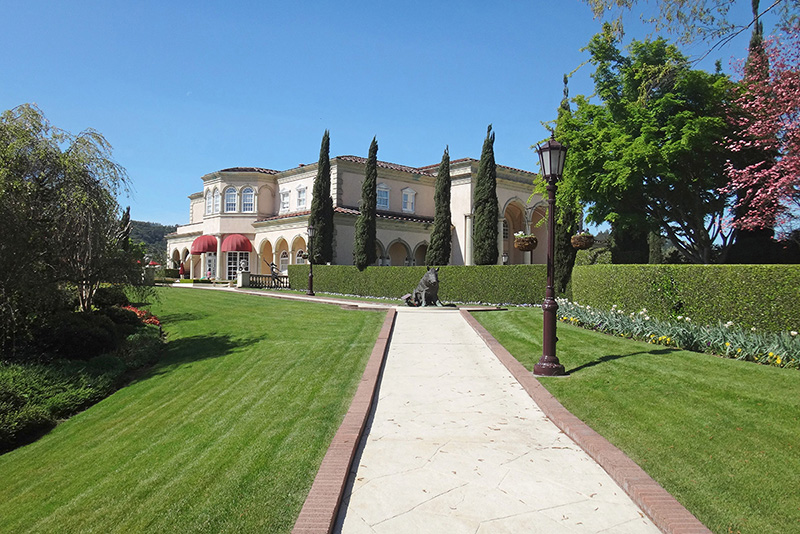
Villa Fiore, with its tasting room and lovely outdoor terrace, overlooks the Ferrari-Carano vineyards.
8761 Dry Creek Road, Healdsburg, CA 95448
Visit March and April for tulip display
|
(707) 433-6700 or (800) 831-0381 |
|
Open daily 10am–5pm, except major holidays |
|
Admission free; fee for wine tastings |
|
No dogs |
Small but lush garden within a winery in the picturesque Sonoma countryside
If you’re visiting the wine country north of San Francisco and would like to combine a wine tasting with a garden visit, Ferrari-Carano Vineyards and Winery makes for a pleasant stop. The gardens here are not extensive, but they’re pretty, peaceful, and impeccably maintained.
There’s more than a little Las Vegas extravagance at play in this hugely successful winery. Not surprising, since the owners, Don and Rhonda Carano, made their mark with a hotel and casino in Reno, Nevada. Anyone who knows anything about having a successful hotel knows that attention to detail is everything. You’ll see that here, in the immaculately groomed grounds, vineyards, gardens, and the enormous Tuscan-style Villa Fiore that serves as the tasting room, enoteca, and retail center.
The Caranos never planned to create a California wine empire, but they’re the kind of people who don’t do anything in a half-hearted manner. They first visited Sonoma County in the late 1970s on a wine-buying trip for their hotel. The intoxicating beauty of the Northern California wine country, where grapes have been grown since the 1850s, took hold of them almost immediately. They fell in love with the countryside because it reminded them of Tuscany, and a year later they purchased their first seventy acres of terroir. Today they have four vineyards in addition to this one in Dry Creek Valley, five appellations in all (an appellation is a legal designation of an area for growing wine grapes).
The five-acre walled garden Rhonda created in the old prune orchard is meant to complement Villa Fiore and the surrounding vineyards. It’s really a pleasure garden, a place to stroll and relax among some 2,000 species of plants. This is not a mature, long-established garden—it was planted in the space of eight months—but you will find mature plants within it. Something is blooming or of seasonal interest year-round.
Before you enter the garden, I feel obliged to send out a Tulipa alert. If you suffer from tulipomania, and like to feast your eyes on vast displays of tulips and daffodils to get your gardening motor running in the spring, plan your visit to Ferrari-Carano for March. That’s when there’s a no-holds-barred floor show featuring 10,000 tulips and daffodils arranged in beds and around a spouting fountain in front of the villa. It’s a sight that would make all those old Tuscan winemakers drop their jaws in wonder. All this and good wine, too? Let’s call it Appellation Spring. If you miss the tulips and visit later in the year, you’ll find other showy performers in their place. Giant begonias, perhaps.
A gate laden with wisteria and framed by hornbeams welcomes you to the grounds of this wine estate. A long, curved pathway leads up a gentle incline lined with a lush, manicured lawn to Villa Fiore. This was formerly flatland, like the vineyards that surround the villa. About halfway up you’ll pass a giant bronze sculpture of a wild boar. Beyond that is the entrance to the villa, with a sunny terrace in front overlooking the vineyards and the fountain garden. Stop in here if you want to do a wine tasting or sample their signature fume blanc.
The walled garden, called the Arena, is down and to the side of the villa. In the hot, dry Sonoma summers, the garden with its trees and water-feature stream is the coolest spot on the property. A bevy of specimen trees provides much of the interest. Upon entering, you’ll encounter a weeping Norway spruce (Picea abies ‘Pendula’) and beautiful river birches (Betula nigra). Spring blossoms adorn ornamental trees like the Japanese snowbell tree (Styrax japonicus); Camellia japonica ‘Nuccio’s Pearl’, with vivid, roselike flowers; a Kousa dogwood; and a tulip tree (Liriodendron tulipifera) or saucer magnolia (Magnolia ×soulangeana). And since you’re at a winery, have a look at the three cork trees (Quercus suber). This species is the principle source of cork for wine bottles.
A stream threads through the garden between ponds at either end. A small Japanese-style garden around the far pond is planted with Japanese flowering cherries (Prunus ‘Kanzan’) with double white blossoms in the spring, weeping Japanese cherries (Prunus subhirtella ‘Pendula’) with pink blossoms, and Japanese maples (Acer palmatum ‘Seiryu’) that turn crimson in the fall.
When your garden visit is over, head back to Villa Fiore to enjoy a glass of vino on that sunny terrace. From there, the expansive view of neatly tended vineyards and silvery green olive trees might trick you into thinking you really are in Tuscany.

Hundreds of specimen plants are found at Ferrari-Carano Vineyards and Winery, among them Quercus suber (cork oak), the tree used for making wine corks.
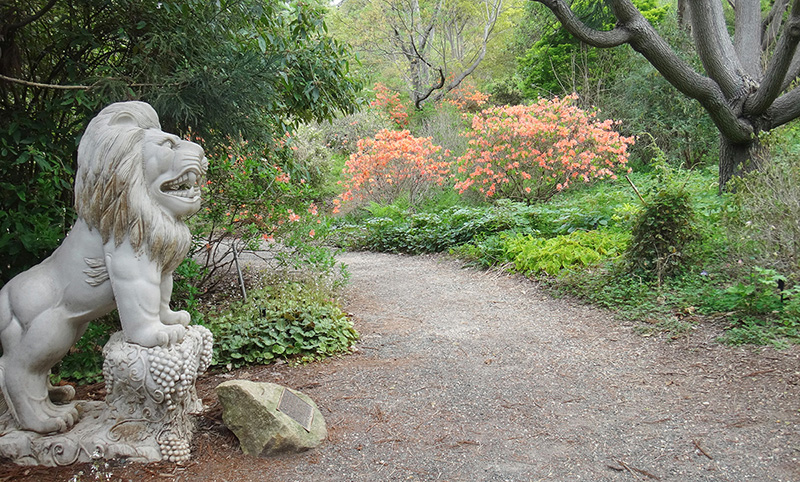
A stone lion, symbol of prosperity and longevity, stands guard at Quarryhill Botanical Garden in Sonoma.
12841 Sonoma Highway, Glen Ellen, CA 95442
Visit year-round; April–June for maximum blooms
|
(707) 996-3166 |
|
Open daily 9am–4pm (entrance closes at 3pm); closed major holidays |
|
Admission fee |
|
Hilly terrain and gravel pathways may be unsuitable for wheelchairs |
|
No dogs |
Some gems are hidden but shouldn’t be. Quarryhill is a truly great botanical garden, yet many people drive past and have no inkling of the riches to be found beyond the grape vines seen from the road. Head to the visitor center, though, and embark on a unique, informative, and enchanting garden experience.
Quarryhill is better known internationally than nationally, in part because of its close partnership with the Royal Botanic Gardens at Kew, in England. Jane Davenport Jansen, who bought the 62-acre property in 1968, wanted her garden to focus on plants from Asia and to be dedicated to conservation. That meant all plants had to come from seeds collected in the wild, and records had to be kept of their provenance and growth habits once planted. Before any plantings got underway, Jansen and her garden designer consulted with the botanists at Kew and the UC Botanical Garden at Berkeley. The goal was not to create an ornamental garden, but a garden that looked completely natural. Each plant in the extraordinary palette was planted in what was considered its best location. There are no formal groupings, no imposed style, yet everything looks completely at home.
And yes, every plant, shrub, and tree was grown from seed collected in the wild on plant expeditions to China, the Himalayas, Japan, and Korea. This garden is all the more remarkable when you consider that planting didn’t begin until 1987, making Quarryhill one of California’s newest—yet oldest-feeling—botanical gardens. The garden is beautiful year-round, but really shines in the spring and early summer, when the surrounding foothills of the Mayacamas Mountains are green and many of the exotic trees and shrubs are in full flower.
Strolling through this lush garden, it’s hard to imagine what it looked like when Jansen bought the property. Back then, the entire area was recovering from a massive wildfire that had swept through the mountains in 1964. Thickets of fast-growing madrone and knobcone pine had re-established themselves on the hillsides but little else grew. A rock quarry operation had gouged out deep declivities in the valley floor, where a stream once flowed. Today those old eyesore quarries are Monet-like ponds shimmering with pink and white waterlilies, and the once charred hillsides are covered with thousands of plants that are rare, threatened, or endangered in their native habitats.
On your way to the wild portion of the garden, you’ll pass a circular rose garden overlooked by a spectacular yellow Lady Banks’ rose that has made its home in a giant oak. This garden tells the story of the Chinese origins of the modern rose. In a nutshell, about half of the 200 or so wild roses in the world are found in China; their predominant trait is that they are repeaters (they bloom more than once during the growing season). The old roses of Europe, on the other hand, had a single bloom in the spring. About two centuries ago, the tea rose and the China rose made their way from China to Europe and were crossed with European varieties. Four new roses, the so-called stud roses, were created and became the progenitors of all modern hybrid roses. Four quadrants in the rose garden are planted with examples of these studs, which look rather delicate and demure.
Farther on, two stone pillars mark the entrance to Quarryhill’s real glory: the 25-acre botanical garden. Wide gravel paths meander up and down hillsides planted with wild (and wild-collected) rhododendrons, camellias, peonies, and magnolias, among others. A map from the visitor center pinpoints some of the rarer specimens, and plants are labeled. If you take the path that heads south from the entrance pillars, you’ll come to a rare and critically threatened Chinese maple (Acer pentaphyllum) that grows only along the Yalong River in western Sichuan. Plans are underway to dam the Yalong, which will submerge and destroy this tree’s entire native habitat. It’s an example of why these plants are disappearing in the wild, and why it’s so important to conserve them in places like Quarryhill.
At the north end of the nearby semicircular arbor path, Rosa chinensis var. spontanea, a China rose once thought to be extinct, cascades over a rock wall and blossoms with pink, white, or red flowers in February or March. From here, take the path heading east to see Cornus capitata, a lovely evergreen dogwood from southern Sichuan that was a favorite of Jane Jansen.
Speaking of trees, look for the rare Emmenopterys henryi, which grows beside a path in the very heart of the garden. Renowned English plant explorer Ernest Wilson pronounced it “one of the most strikingly beautiful trees in the Chinese forest.” He took specimens back to England, where they stubbornly refused to blossom for seventy-five years—though the specimen at Quarryhill flowered after just six. The garden is also home to a dawn redwood (Metasequoia glyptostroboides), a deciduous Chinese redwood closely related to coast and Sierra redwoods and long thought to be extinct in the wild. In 1941, a stand was discovered in a remote valley in central China. If you’re visiting in winter, you’ll also be dazzled by the thick red-orange berry clusters on the dioecious ligiri tree (Idesia polycarpa) from Japan.
As for color, the orange-red to salmon-red blossoms of the Japanese azalea (Rhododendron japonicum) delight the eye every spring. And for fragrance, the early autumn leaves of the Katsura tree (Cercidiphyllum japonicum) produce a scent that smells like cotton candy to some, fresh strawberries to others.
Take your time at Quarryhill and you’ll leave with a deeper appreciation of the richness of Asia’s native flora, as well as an increased awareness of the environmental pressures that threaten wild plants everywhere.
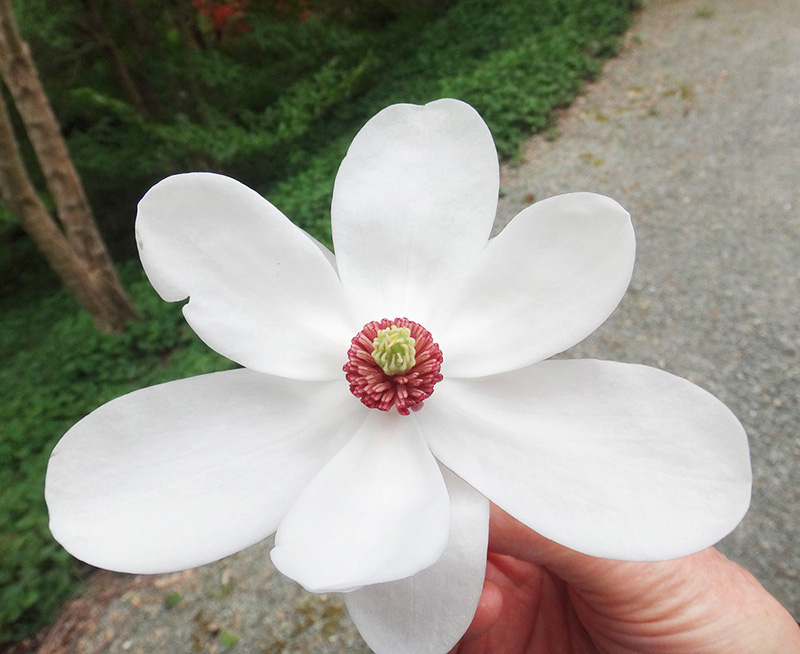
The exquisite flower of Magnolia wilsonii, a tree grown from seed collected in Asia.